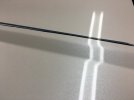I painted my truck over three years ago with a pearl base and top coated with universal clear. Applied four coats of clear and cut with 800, 1000, 1200, 1500, 2000 and rubbed with wool and foam pads for a smooth finish. Truck spent two winters outside storage in NY snow, driven during the good weather months. Two years ago I gave it a good polishing to remove some swirl marks n hazy spots. Last year it was covered and stored inside, non heated. This year I noticed that the hood has a texture which is a little rough.
Three years ago I painted a camaro with spi black urethane and four coats universal clear. Same cut and polish procedure. Car went to owners garage and just returned to shop for assembly. Was sitting in an unheated barn before moving into shop. I just looked at it, and the finish has a fine texture all over it. It is very uniform, not spotty or in a couple areas. Any idea as to what is going on? Just painted another camaro with same paint and process. Owner is worried his car is going to do the same. Is it possibly the freezing doing something? Is there a way to prevent this from happening?
Attached is a photo of the truck. The first camaro done in black is much rougher.
Three years ago I painted a camaro with spi black urethane and four coats universal clear. Same cut and polish procedure. Car went to owners garage and just returned to shop for assembly. Was sitting in an unheated barn before moving into shop. I just looked at it, and the finish has a fine texture all over it. It is very uniform, not spotty or in a couple areas. Any idea as to what is going on? Just painted another camaro with same paint and process. Owner is worried his car is going to do the same. Is it possibly the freezing doing something? Is there a way to prevent this from happening?
Attached is a photo of the truck. The first camaro done in black is much rougher.

